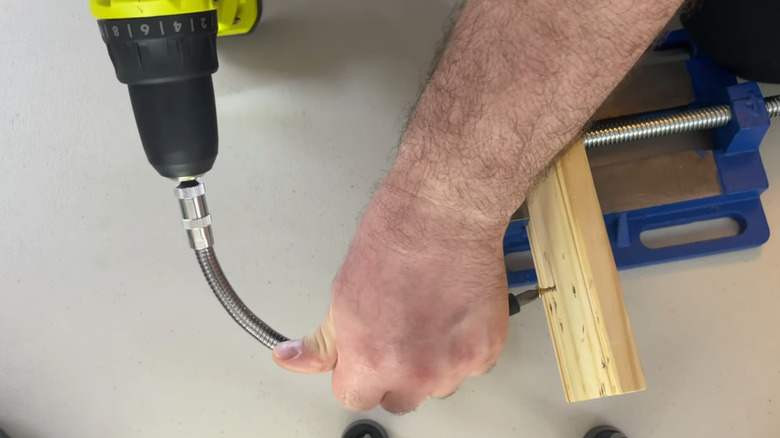The Ryobi Drill Bit Attachment That Lets You Access Hard-To-Reach Places
We may receive a commission on purchases made from links.
There's a reason that a cordless power drill is considered one of the bedrock implements of any proper toolbox: It's compact, powerful, and can handle most assorted screws, bolts, and other fasteners. The only real shortcoming of a power drill is that, despite its relative portability, it can be a bit top-heavy and oftentimes too bulky to fit into tight nooks. This could be a problem if you're trying to loosen or tighten something in cramped confines, such as the depths of your car's hood or a bracket all the way in the back of a drawer. Ryobi makes a right-angle drill for reaching tight spots, but that only works if the fastener is positioned at a right angle.
However, the neat thing about drills is that they have quite a few unexpected uses. For instance, rotational energy generated by these tools is a lot easier to transfer than you may expect. Positioning a solid bit in a straight line will convey the most force from the motor, sure, but as long as there's a physical connection, you could still transfer that rotational force through a long, flexible line. That's the principle behind Ryobi's 11-inch Flexible Shaft Bit Holder, which can be plugged into a drill and hold a bit to be worked into otherwise inaccessible gaps.
The Flexible Shaft Bit Holder can be snaked into tight spots
The Ryobi Flexible Shaft Bit Holder utilizes a fairly simple design to transfer your drill's rotational action over a longer distance and through confines that you may not be able to navigate in a straight line. It's made up of an 11-inch shaft constructed from flexible metallic links, which allows the attachment to bend and flex up to 90 degrees.
One end of the attachment has a receiver that you can plug your tool's shank into, while the other has a bit holder to insert whatever piece you want to use after choosing the right bit for your Ryobi drill. The holder is magnetic, so the bit won't fly out during use. Rather than clamping directly onto your tool's shank, which would cause the entire attachment to spin with it, the shaft instead transfers the drill's rotation through the receiver directly into the bit, while the shaft itself stays stationary.
With this design, you can snake the shaft into those tight spots, stick the held bit into a fastener, then run the drill to tighten or loosen. Besides reaching spots that you might not be able to fit the whole tool into, this could be useful for fasteners placed at odd angles or orientations that are technically accessible but facing in a direction that the shank of your drill can't reach effectively.

